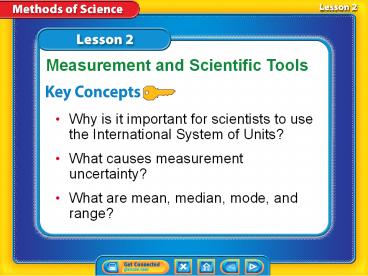Lesson 2 Reading Guide - KC - PowerPoint PPT Presentation
Title:
Lesson 2 Reading Guide - KC
Description:
Measurement and Scientific Tools Why is it important for scientists to use the International System of Units? What causes measurement uncertainty? – PowerPoint PPT presentation
Number of Views:159
Avg rating:3.0/5.0
Title: Lesson 2 Reading Guide - KC
1
Lesson 2 Reading Guide - KC
Measurement and Scientific Tools
- Why is it important for scientists to use the
International System of Units? - What causes measurement uncertainty?
- What are mean, median, mode, and range?
2
Lesson 2 Reading Guide - Vocab
Measurement and Scientific Tools
- description
- explanation
- International System of Units (SI)
- significant digits
3
Lesson 2-1
Description and Explanation
- A description is a spoken or written summary of
observations. - When making a qualitative description, you use
your senses to describe an observation. - When making a quantitative description, you use
numbers and measurements to describe an
observation. - An explanation is an interpretation of
observations.
4
Lesson 2-1
Description and Explanation (cont.)
- At one time, scientists in different parts of the
world used different units of measurement. - Sharing scientific information was difficult and
led to confusion.
5
Lesson 2-1
Description and Explanation (cont.)
- A system of measurement was adopted to eliminate
confusion. - The International System of Units (SI) is the
internationally accepted system for measurement.
6
Lesson 2-1
Description and Explanation (cont.)
- A base unit is the most common unit used in the
SI system for a given measurement.
7
Lesson 2-1
Description and Explanation (cont.)
- SI uses prefixes to identify the size of a unit.
- Prefixes are used to indicate a fraction of ten
or a multiple of ten.
8
Lesson 2-1
Description and Explanation (cont.)
- To convert SI units, you must multiply or divide
by a factor of ten.
9
Lesson 2-1
Description and Explanation (cont.)
- There is uncertainty in any measurement because
determining exact measurements with certainty can
be problematic. - The tools used to take measurements can limit the
accuracy of the measurements.
10
Lesson 2-1
Description and Explanation (cont.)
- Because scientists duplicate each others work,
they must record numbers with the same degree of
precision as the original data. - Significant digits are the number of digits in a
measurement that you know with a certain degree
of reliability. - To achieve the same degree of precision as a
previous measurement, it often is necessary to
round a number.
11
- If the digit to the right of the digit being
rounded is less than 5, the digit being rounded
stays the same if the digit to the right of the
digit being rounded is 5 or higher, the digit
being rounded is increased by one.
12
Lesson 2-1
13
Lesson 2-1
Description and Explanation (cont.)
- Scientists often need to analyze their data to
obtain information. - Four values often used when analyzing numbers are
median, mean, mode, and range.
14
Lesson 2-1
Description and Explanation (cont.)
15
Lesson 2-1
Description and Explanation (cont.)
16
Lesson 2-1
Scientific Tools
- A science journal is used to record observations,
questions, hypotheses, data, and conclusions from
scientific investigations. - Rulers and metersticks are used to measure
lengths and distances the SI unit is meter (m). - Graduated cylinders measure the volume of a
liquid the typical units are liters (L) or
milliliters (mL).
17
Lesson 2-1
Scientific Tools (cont.)
- A triple-beam balance is used to measure the mass
of an object mass is measured in grams (g) or
kilograms (kg). - A thermometer is used to measure the temperature
of a substance in degrees Celsius. - Computers are used for collecting, organizing,
and storing information about a research topic or
scientific investigation.
18
Lesson 2-1
Tools Used by Earth Scientists
- Binoculars are instruments that enable people to
view distant or faraway objects more clearly. - A compass is an instrument that shows magnetic
north and is used by scientists to navigate and
determine the direction of objects when they are
in the field.
19
Lesson 2-1
Tools Used by Earth Scientists (cont.)
- A wind vane is a device, often attached to the
roofs of buildings, that rotates to show the
direction of the wind. - An anemometer, or wind-speed gauge, is used to
measure the speed and the force of wind. - A streak plate is a piece of hard, unglazed
porcelain that helps you identify minerals by
their streak color.
20
Lesson 2 LR1
Which term refers to the number of digits in a
measurement that you know with a certain degree
of reliability?
A. International System of Units B. mean C. median
D. significant digits
21
Lesson 2 LR2
Which refers to the most common unit used in the
SI system for a given measurement?
A. base unit B. mode C. prefix D. range
22
Lesson 2 LR3
Which is used to measure lengths and distances?
A. beaker B. ruler C. triple-beam
balance D. thermometer




















![Honors Level Course Implementation Guide [English Language Arts] PowerPoint PPT Presentation](https://s3.amazonaws.com/images.powershow.com/7928665.th0.jpg?_=20160626066)










